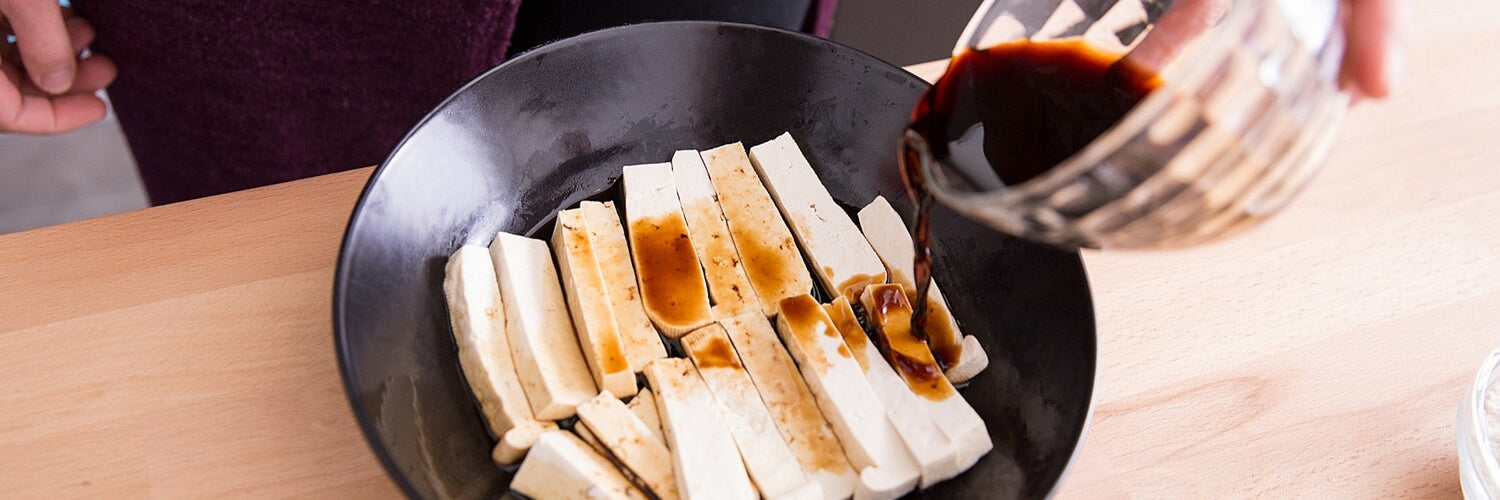
Japanese Cooking 101, Techniques
Japanese Cooking Technique: Soy Sauce Based Marinating and Pickling
3 minutes
Want to know the secrets of classic Japanese flavors? Look no further. Soy-based pickled and marinated foods are quick, easy and packed with umami.
Soy sauce based marinating and pickling work on foods two ways: not only does it add flavor, the salt in soy sauce acts as a brine. Therefore, it increases the moisture in meats and vegetables just as a salt brine does. Add a little vinegar to a soy-based marinade, and you initiate the pickling process of preservation. When marinating, the soy sauce adds flavor and a hefty dose of umami, something you can almost never have too much of. The same goes with pickling; you’ll get double the umami in vegetables from the soy-vinegar combination.
Soy Sauce Based Marinating
As soy sauce acts as a brining agent, it initially draws moisture out of the protein fibers through the process of osmosis. After the moisture is drawn out, it mixes with the sodium in the soy sauce to form a brine, which in turn partially breaks down the muscle fibers, resulting in a tender, flavorful, moist cut of meat.
The soy-based marinating process for meats takes anywhere from two to 12 hours, depending on the type of meat and its initial toughness. Naturally tender poultry, for example, requires only about a two- to four-hour marinating time, whereas a tough cut of beef, say one from the chuck or round, needs at least eight to 12 hours to receive the tenderizing effects of the marinade. Vegetables and seafood only need about 15 minutes of marinating time, whereas tofu needs about 30 minutes of marinating time.
Soy-based marinades also need a carrier, such as vegetable oil, to help disperse the soy evenly over the protein. You can add secondary ingredients, such as garlic, ginger or lemongrass, to bolster and accentuate the flavors of the dish. Unlike conventional marinades, there’s no need to add an acidic ingredient to a soy-based marinade unless you wish to add an additional layer of flavor.
Soy Based Marinade
Recipe presented by Jay Andrews

Ingredients
Instructions
- Whisk together all the ingredients and set aside.
- Prepare up to two pounds of uncooked protein or vegetables and add them to a sealable plastic bag. You can leave the protein or vegetables whole or slice it into 1/2- to 1-inch pieces; the most important factor here is uniformity of size.
- Add the marinade and give everything a vigorous shake.
- Set the bag in a shallow dish and place it in the fridge. Marinate beef for up to 12 hours; chicken for up to four hours; seafood and vegetables for up to 30 minutes.
- After marinating, you can prepare the meat or vegetables in any manner; roasting, frying and grilling, for example, work exceptionally well.
Soy Sauce Based Pickling
Soy-based pickling produces a dish with a distinctly Japanese flavor profile, one that melds the pleasant acidity of rice vinegar, the umami of soy sauce and a touch of sweetness from mirin or sugar to temper any harsh flavors. The soy here serves two purposes: it adds its classic flavor while acting as a preservative through brining, thereby extending the shelf life of the final product.
The vinegar acts as the catalyst for the pickling process. Through anaerobic fermentation, the vegetables produce beneficial bacteria while preventing the growth of harmful microbes. You can use the soy-based pickling technique to preserve just about any vegetable, from peppers to onions to daikon, as is used in the traditional Japanese pickle tsukemono.
The pickling process typically takes anywhere from a few minutes to a couple days, depending on how bold you wish the final flavor to be. However, the shorter the pickling time the shorter the shelf life. A quick-pickled daikon tsukemono typically has the shelf life of any perishable food, that is to say two to three days when stored in an airtight container in the refrigerator.
